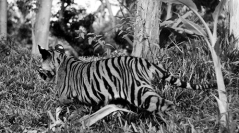

 Anthropozoologica
58 (4) - Pages 35-58
Anthropozoologica
58 (4) - Pages 35-58The Jawi of Southern Thailand form a cultural conservatory of the ancient peninsular Malay world of which they testify. Islam arrived in their country at the end of the 14th century. However, Islam was present overall among the elites and coastal population and it spread in the highlands only slowly. Like the Malays, they were first animists and then Hindu, influenced by India. They retain the imprint in their ritual beliefs and practices and in the myths of the oldest background. The example of the tiger, a predator that largely dominates the local fauna and the fabulous bestiary of the Jawi and the Malays, shows this well. The myth of the origin of the tiger and that of its stripes mixes animist and Indian sources with more recent Muslim currents and associates with the tiger the figures of the bull and the buffalo, the lion, the archangel Gabriel, the devil and Sayidina Ali, son-in-law of the Prophet Muhammad and Malay cultural hero.
Malay world, animism, Hinduism, Islam, cosmogony, metamorphosis.